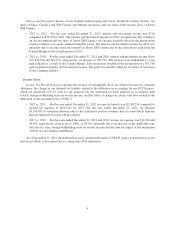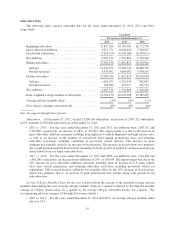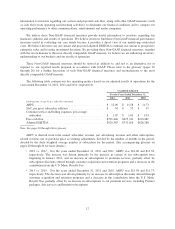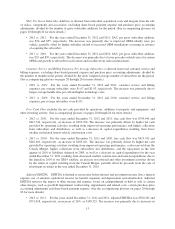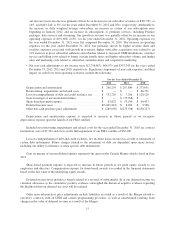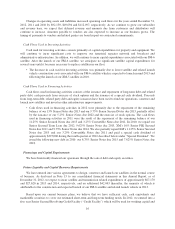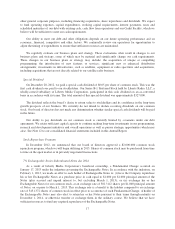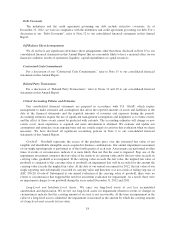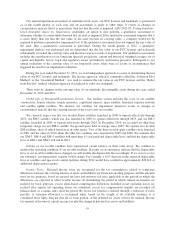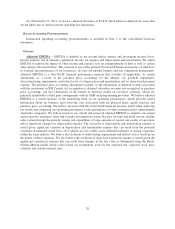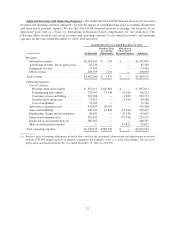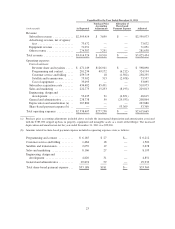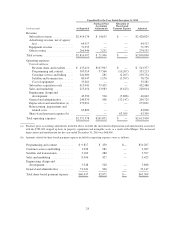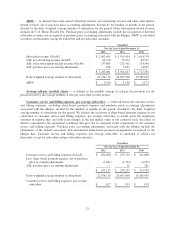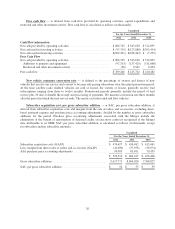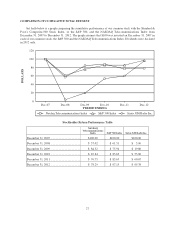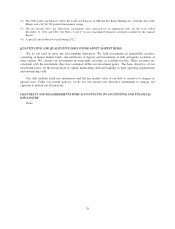XM Radio 2012 Annual Report Download - page 75
Download and view the complete annual report
Please find page 75 of the 2012 XM Radio annual report below. You can navigate through the pages in the report by either clicking on the pages listed below, or by using the keyword search tool below to find specific information within the annual report.Our annual impairment assessment of indefinite-lived assets, our FCC licenses and trademark, is performed
as of the fourth quarter of each year and an assessment is made at other times if events or changes in
circumstances indicate that it is more likely than not that the asset is impaired. ASU 2012-02, Testing Indefinite-
Lived Intangible Assets for Impairment, establishes an option to first perform a qualitative assessment to
determine whether it is more likely than not that an asset is impaired. If the qualitative assessment supports that it
is more likely than not that the fair value of the asset exceeds its carrying value, a company would not be
required to perform a quantitative impairment test. If the qualitative assessment does not support the fair value of
the asset, then a quantitative assessment is performed. During the fourth quarter of 2012, a qualitative
impairment analysis was performed and we determined that the fair value of our FCC licenses and trademark
substantially exceeded the carrying value and therefore was not at risk of impairment. Our qualitative assessment
includes the consideration of our long term financial projections, current and historical weighted average cost of
capital and liquidity factors, legal and regulatory issues and industry and market pressures. Subsequent to our
annual evaluation of the carrying value of our long-lived assets, there were no events or circumstances that
triggered the need for an impairment evaluation.
During the year ended December 31, 2011, we used independent appraisals to assist in determining the fair
value of our FCC licenses and trademark. The income approach, which is commonly called the “Jefferson Pilot
Method” or the “Greenfield Method”, was used to estimate the fair value of our FCC licenses and the “Relief
from Royalty” method valuation approach was utilized to value our trademark.
There were no changes in the carrying value of our indefinite life intangible assets during the years ended
December 31, 2012 and 2011.
Useful Life of Broadcast/Transmission System. Our satellite system includes the costs of our satellite
construction, launch vehicles, launch insurance, capitalized interest, spare satellite, terrestrial repeater network
and satellite uplink facilities. We monitor our satellites for impairment whenever events or changes in
circumstances indicate that the carrying amount of the asset is not recoverable.
We currently expect our first two in-orbit Sirius satellites launched in 2000 to operate effectively through
2013, our FM-3 satellite, which was also launched in 2000, to operate effectively through 2015, and our FM-5
satellite, launched in 2009, to operate effectively through 2024. In December 2010, we recorded an other than
temporary charge for our FM-4 satellite, the ground spare held in storage since 2002. We operate five in-orbit
XM satellites, three of which function as in-orbit spares. Two of the three in-orbit spare satellites were launched
in 2001 and the other in 2010 while the other two satellites were launched in 2005 and 2006. We estimate that
our XM-3, XM-4 and XM-5 satellites will meet their 15 year predicted depreciable lives, and that the depreciable
lives of XM-1 and XM-2 will end in 2013.
Certain of our in-orbit satellites have experienced circuit failures on their solar arrays. We continue to
monitor the operating condition of our in-orbit satellites. If events or circumstances indicate that the depreciable
lives of our in-orbit satellites have changed, we will modify the depreciable life accordingly. If we were to revise
our estimates, our depreciation expense would change. For example, a 10% decrease in the expected depreciable
lives of satellites and spacecraft control facilities during 2012 would have resulted in approximately $20,616 of
additional depreciation expense.
Income Taxes. Deferred income taxes are recognized for the tax consequences related to temporary
differences between the carrying amount of assets and liabilities for financial reporting purposes and the amounts
used for tax purposes, based on enacted tax laws and statutory tax rates applicable to the periods in which the
differences are expected to affect taxable income. In determining the period in which related tax benefits are
realized for book purposes, excess share-based compensation deductions included in net operating losses are
realized after regular net operating losses are exhausted; excess tax compensation benefits are recorded off
balance-sheet as a memo entry until the period the excess tax benefit is realized through a reduction of taxes
payable. A valuation allowance is recognized when, based on the weight of all available evidence, it is
considered more likely than not that all, or some portion, of the deferred tax assets will not be realized. Income
tax expense is the sum of current income tax plus the change in deferred tax assets and liabilities.
19


